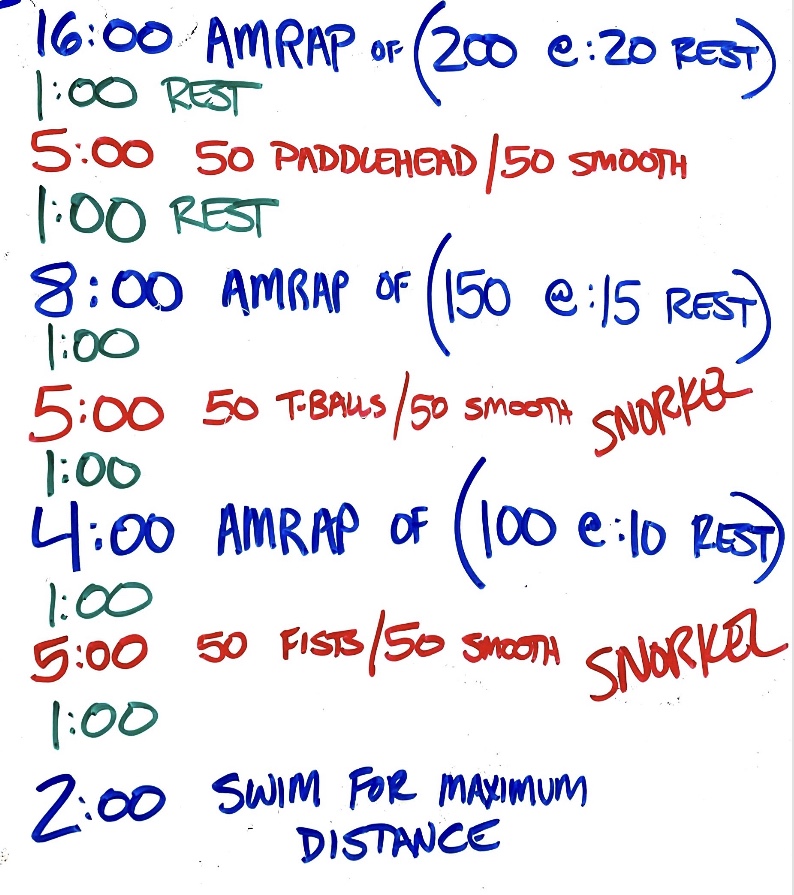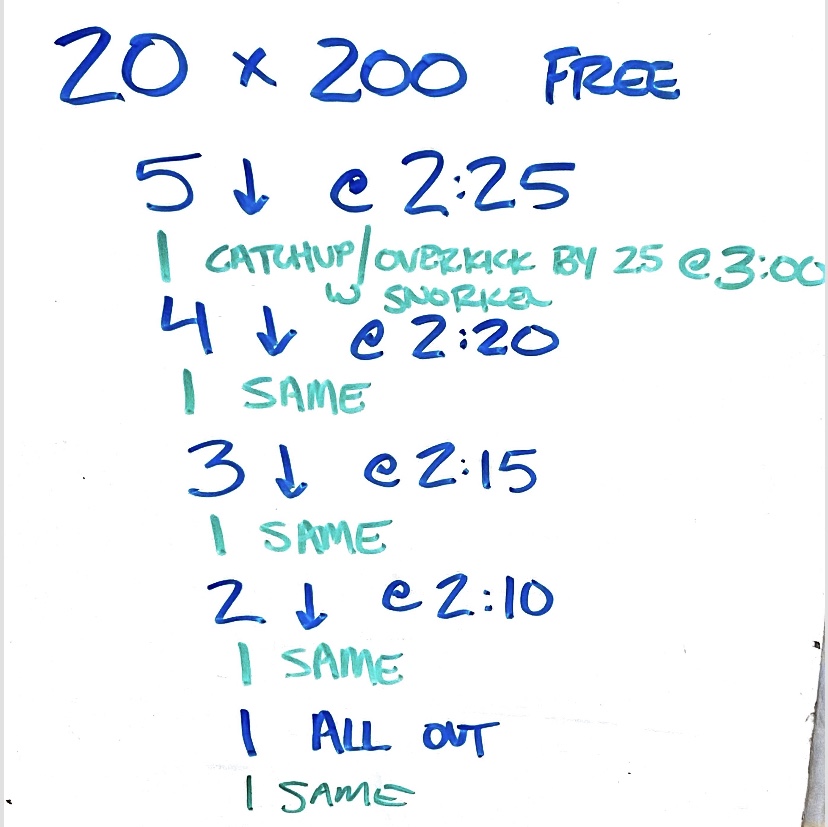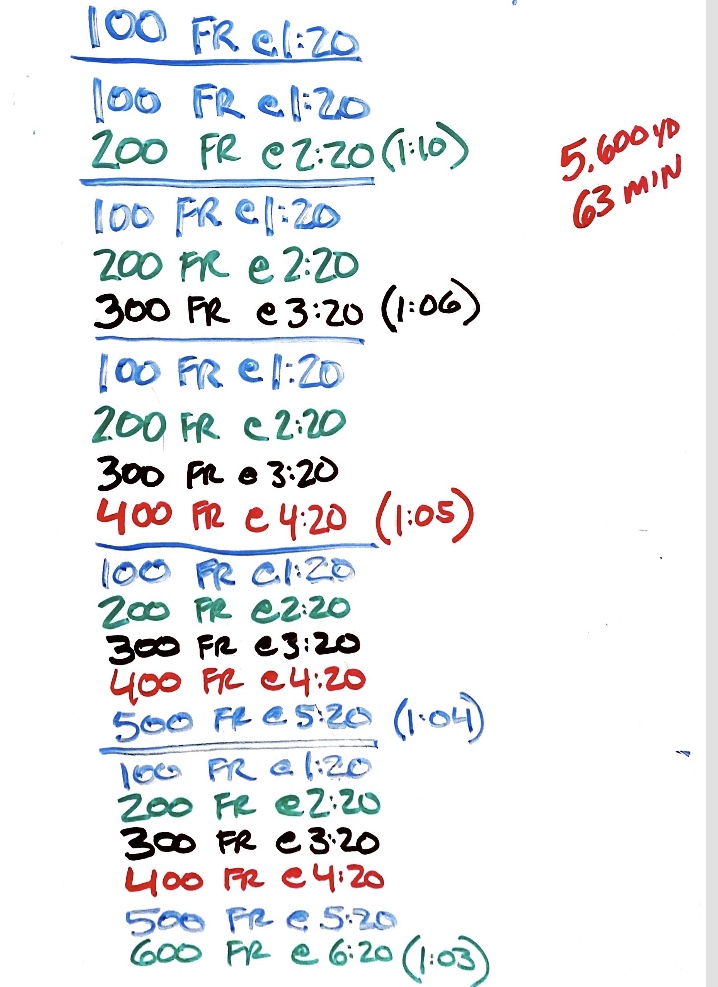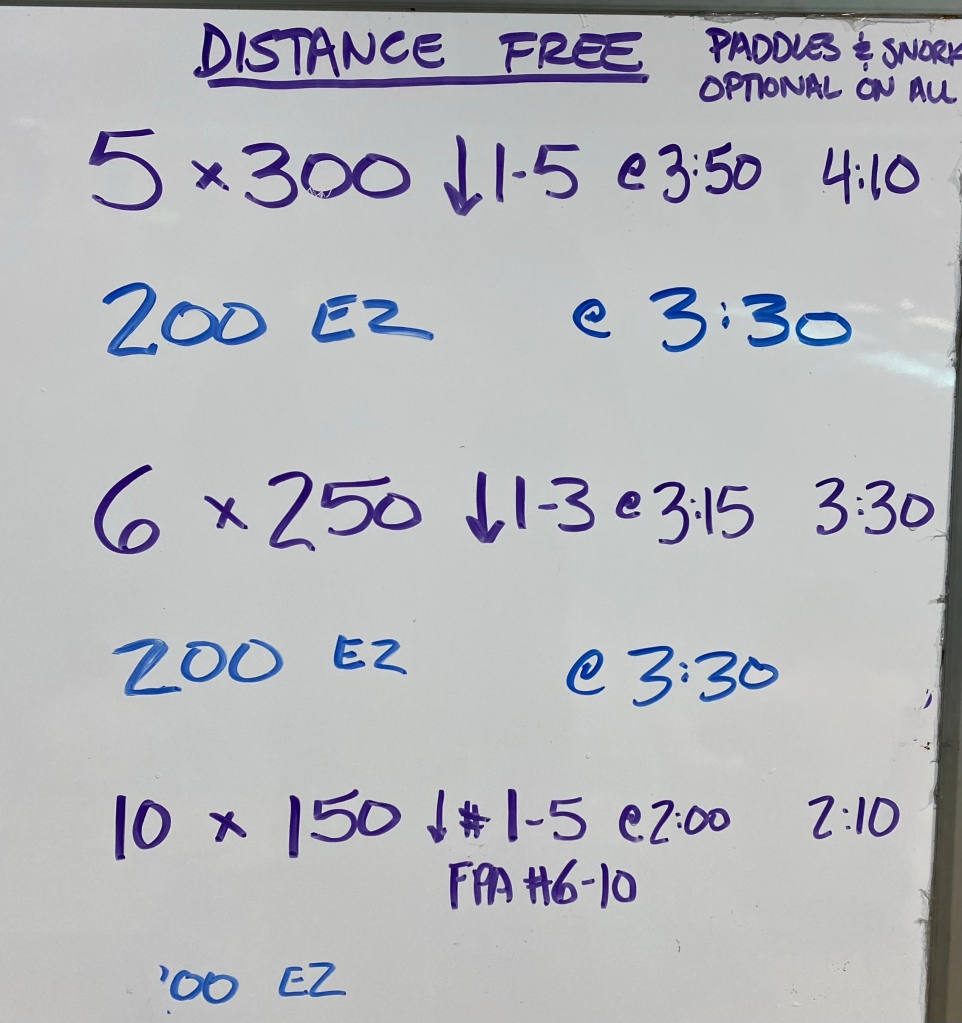Ryan Woodruff, Lynchburg YMCA
SCM
Within each descend set, we aimed to descend to a slightly faster time each time.

Free Swimming Workouts, Sets, Ideas, and Dryland Exercises from Professional Coaches Around the World
Ryan Woodruff, Lynchburg YMCA
SCM
Within each descend set, we aimed to descend to a slightly faster time each time.

Ryan Woodruff, Lynchburg YMCA
The broad aim of this set was to give our group (that has a wide range of speeds for middle-distance swims) a challenge to push themselves on the 400 while still getting some recovery/drill/technique work in. We timed the 400s and then swimmers would start right into the fartlek (continuous swimming). After 5-7 minutes of the fartlek, I would verbally stop the group and we would rest a minute before starting the next 400. FPA = fastest possible average. K.O.S. = Kick on Side

Ryan Woodruff, Lynchburg YMCA
SCM
The 400s here got down to a challenging interval by the last one. The sets of 4 x 100s in between were on moderate interval. Just getting good work in. The two columns represent an A and B interval within our group.

Ryan Woodruff, Lynchburg YMCA
SCM. For the 400s and 200s, swimmers were instructed to do an open turn before the “strong” part to check the clock and get their split. The emphasis is always on being fast at the end of each repeat and the end of the set.

Ryan Woodruff, Lynchburg YMCA
SCY

Ryan Woodruff, Lynchburg YMCA
Some old-fashioned distance work today. This was for two of our distance swimmers who are about 30 seconds apart in their best times. One went 500s and the other went 450s. Worked out pretty well for both on this set. Base paces for each distance are in parentheses.

Ryan Woodruff, Lynchburg YMCA
SCM. We aimed to hit a range of speeds and improve our self-awareness of our pacing.

Ryan Woodruff, Lynchburg YMCA
SCY
Progress through the sets 1 through 6 in order with the extra :30 rest after each set. The interval pattern in this set is suitable for an athlete with a threshold pace around 1:00.

Ryan Woodruff, Lynchburg YMCA
SCY

Ryan Woodruff, Lynchburg YMCA
SCM
At the beginning of my career (20+ years ago), I would have my team do a T-30 test multiple times per season. Since that time, I have gradually moved away from long steady paced swims such as that. The set below is the kind of thing I am more likely to do now. Each of the timed sets is “As Many Rounds As Possible” (AMRAP) with a set distance and rest to repeat. The amount of rest scales down with the distances, which allows for a pretty direct comparison of pace as the times decrease. We recorded each swimmer’s distances (to the nearest meter) on a dry erase board for all to see. As the time was cut in half, swimmers were urged to exceed 1/2 of their previous distance on the next swim. The 5:00 swims in between allowed for recovery and emphasis on technical reminders. Overall, it was a successful set with high levels of effort and engagement!

Ryan Woodruff, Lynchburg YMCA
SCY

Ryan Woodruff, Lynchburg YMCA
SCM
The format is similar to my most recent other post, with a more aerobic focus. The intervals stay the same for each part, with the quantities at each interval shifting slightly. The effect is a set that gets steadily a bit harder, with the peak intensity coming in the final 4 x 150 at the end. FPA = Fastest Possible Average.

Ryan Woodruff, Lynchburg YMCA
SCY

Ryan Woodruff, Lynchburg YMCA
The basic concept here is to ramp up the challenge by adding a constant amount to the interval with each increasing 100 so that the average pace gets progressively harder. In this case, we added 1:00 each time so that all of the intervals ended in :20. Maybe for your swimmer the way to keep the set challenging but doable would be to add :55 or 1:05 or 1:15, but I like the symmetry of this set-up.
In this case, the lines are there to highlight the pattern. You could certainly insert brief breaks or recovery swims if needed.
The way the set is written, the swimmer does 5,600 yards in 63 minutes, an average of 1:07.5 for the interval.
SCY

Ryan Woodruff, Lynchburg YMCA

Ryan Woodruff, Lynchburg YMCA
SCM
On the 300s, the focus was on breathing every 3 strokes and executing good turns. On the 50s, the goal was simply to be at 1650 free pace (PMile).

Ryan Woodruff, Lynchburg YMCA
SCM

Ryan Woodruff, Lynchburg YMCA
We have days where the whole group does one workout. Other times, we split by strokes. On this day, we split along distance lines. Part of the group worked around their distance race pace, while the other group did a small number of intense 50s from a dive. The sprinters also watched their 50s back on video and did some active recovery during the 6:00 interval. This workout was in LCM.

Ryan Woodruff, Lynchburg YMCA
SCY

Ryan Woodruff, Lynchburg YMCA
This set was done a day after a very intense quality set of 50s. The aim was to be a bit less intense while covering some distance, then hitting a leg-heavy backstroke set. SCY.

Ryan Woodruff, Lynchburg YMCA

This set was seeking a very specific pattern of pacing on each 600, as indicated by the line graph for each one. Failure to split it correctly meant repeating that 600. To interpret…
#1 – 300 at a consistent pace, 300 at a faster pace, also consistent
#2 – 3 x 200 descend, each one at a consistent pace
#3 – 2 sets of 3 x 100 descending
#4 – 4 x 100 descend + 200 fast and consistent
#5 – 3 x 100 descend + 300 fast and consistent
#6 – 2 x 100 descend + 400 fast and consistent
Here is how it turned out for our swimmer, with splits written next to each graph:

We had to do the first 600 twice due to some early set rusty-ness. Splits for the first of those two are not included.
Coach Gwynn Harrison, Bridgewater College
This is a test we do at least 1/season (often 2). I keep all results and have an all-time spread sheet of overall time and times for each effort. This way, swimmers can compare progress from 1st-2nd semester, as well as over course of career at Bridgewater. It started as a way to get the swimmers more comfortable on the blocks, and more able to swim back to back events during dual meets. Mostly, its a mental challenge because it is all the individual events of a college dual meet (short order) back to back, all best effort. I try to do it toward the end of our overload training period to mark the occasion 🙂 Though they complain about it – it occupys a positive tradition in our program
800 Free
200 Free
50 Free
200 IM
100 Fly
100 Free
100 Back
400 Free
100 Breast
**All 100’s + 50 free are done from dive in heats / all others are from push
*We are short course meters pool, so the distance events are 800/400 instead of 1000/500
*We go a 50 recovery after each effort and take an additional 1 minute between efforts
Coach Gwynn Harrison, Bridgewater College
Start at 200 and see how many 200’s you can hit at MILE PACE :30 RI (keep doing until you miss pace. If you miss, go 50 easy, then see how many 175’s you can hit at Mile PACE :30RI. Continue all the way down (with the 50 easy after each ‘miss):
150: 25 RI
125: 20 RI
100: 15 RI
75: 15 RI
50: :10 RI
25: :5 RI
The first time I did this set in the fall, the swimmers enjoyed the concept, but it was chaotic. The second time this week it was fantastic, with a few tweaks. Kids need a printout of each goal time and they need to be prepared to honestly keep track of their own made yardage. It also helps to have no more than 3 swimmers to a lane if possible (or start at opposite ends). It forces swimmers who never lead to take ownership of their own set, so they need to start with that fact in mind. Swimmers will go different yardage amounts in this set. When swimmers have completed their 1650, they then must actively cheer for those still finishing. It was a good galvanizing set for our distance group – and a confidence builder!
Ryan Woodruff, Lynchburg YMCA
We did this set 48 hours after coming off a brief taper for our high school state championships. We took the early descending sets a little light, and really hit the last 1500 pretty strong.

Ryan Woodruff, Lynchburg YMCA
SCY

Ryan Woodruff, Lynchburg YMCA
SCM
Our pool has been a little fuller the last few days with college swimmers coming home to train. This means having to consider our space a little differently when creating workouts.
This one was a good one-size-fits-all for us today. Some speed, some endurance, a little racing, some equipment, and some underwater work.
They are “Christmas 25s” because 12 x 25. For the 2nd round, we pulled 1-gallon buckets, and if swimmers went fr or fly, they were to hold their breathe for last 8m. The fourth round we did the even ones fast from a dive (HVO)
All around a solid day.

Ryan Woodruff, Lynchburg YMCA
This is the kind of set I would have loved as an athlete. Simple. Room to get in a groove and go.

Ryan Woodruff, Lynchburg YMCA
This freestyle set had our kids really working, and we got some excellent results both in the main set and on the broken 500.

Ryan Woodruff, Lynchburg YMCA
B3 = breathe every 3
FPA = Fastest Possible Average

Ryan Woodruff, Lynchburg YMCA
FPA = Fastest Possible Average
